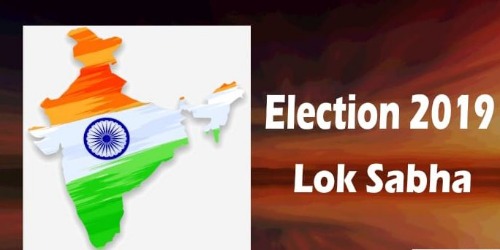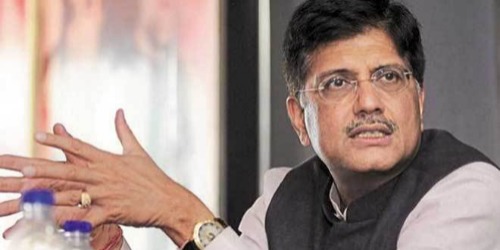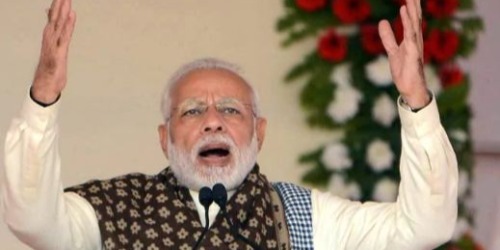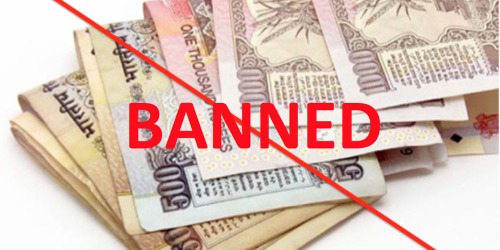Lok Sabha Election 2019: Full Schedule

The Election Commission of India (ECI) on Sunday (March 10) announced the dates for the Lok Sabha election 2019. The Lok Sabha elections will be held in seven phases from April 11 to May 19. The votes will be counted on May 23 and the Lok Sabha election 2019 results will likely be declared on the same day i.e., May 23.
The poll panel also announced the Assembly elections scheduled in Arunachal Pradesh, Andhra Pradesh, Sikkim, and Odisha. The Assembly polls in these four states will be held along with the Lok Sabha election 2019.
The Model Code of Conduct came into effect on Sunday following the announcement of the Lok Sabha election schedule by the Election Commission.
The Lok Sabha election 2019 will be held in seven phases from April 11 to May 19. Below are the dates on which the seven-phase polling will take place.
Phases Polling Dates
I April 11
II April 18
III April 23
IV April 29
V May 6
VI May 12
VII May 19
Lok Sabha election 2019 Schedule: Phase I
The phase I polling for the Lok Sabha elections will be held on April 11. The phase I polls will be held in 91 Lok Sabha or parliamentary constituencies in a total of 20 states.
|
Phase I |
|
|
Date of notification |
March 18 (Monday) |
|
Last date of filing nomination |
March 25 (Monday) |
|
Scrutiny of nominations |
March 26 (Tuesday) |
|
Polling date |
April 11 (Thursday) |
|
Result |
May 23 (Thursday) |
The states that are going to the poll in the phase I of Lok Sabha election are: Andhra Pradesh (25 parliamentary constituencies), Arunachal Pradesh (2), Assam (5), Bihar (4), Chhattisgarh (1), Jammu and Kashmir (2), Maharashtra (7), Manipur (1), Meghalaya (2), Mizoram (1), Nagaland (1), Odisha (4), Sikkim (1), Telangana (17), Tripura (1), Uttar Pradesh (8), Uttarakhand (5), West Bengal (2), Andaman (1) and Lakshadweep (1) .
Lok Sabha election 2019 Schedule: Phase II
The polling in phase II of the Lok Sabha election 2019 will be held on April 18. A total of 97 Lok Sabha constituencies spread across 13 states will be going to polls in phase II.
|
Phase II |
|
|
Date of notification |
March 19 (Tuesday) |
|
Last date of filing nomination |
March 26 (Tuesday) |
|
Scrutiny of nominations |
March 27 (Wednesday) |
|
Polling date |
April 18 (Thursday) |
|
Result |
May 23 (Thursday) |
The states are going to polls in phase II of Lok Sabha election 2019 are: Assam (5 parliamentary constituencies), Bihar (5), Chhattisgarh (3), Jammu and Kashmir (2), Karnataka (14), Maharashtra (10), Manipur (1), Odisha (5), Tamil Nadu (39), Tripura (1), UP (8), West Bengal (3) and Puducherry (1).
Lok Sabha election 2019 Schedule: Phase III
The polling in phase III of the Lok Sabha elections will be held on April 23 in a total of 115 constituencies spread across 14 states.
|
Phase III |
|
|
Date of notification |
March 28 (Thursday) |
|
Last date of filing nomination |
April 4 (Thursday) |
|
Scrutiny of nominations |
April 5 (Friday) |
|
Polling date |
April 23 (Tuesday) |
|
Result |
May 23 (Thursday) |
The states that would be voting in phase III of the Lok Sabha election 2019 are: Assam (4 parliamentary constituencies), Bihar (5), Chhattisgarh (7), Gujarat (26), Goa (2), Jammu and Kashmir (1), Karnataka (14), Kerala (20), Maharashtra (14), Odisha (6), UP (10), West Bengal (5), Dadra and Nagar Haveli (1) and Daman and Diu (1).
Lok Sabha election 2019 Schedule: Phase IV
The Lok Sabha election 2019 phase IV polling has been scheduled for April 29. The polling will be held in a total of 71 constituencies of nine states.
|
Phase IV |
|
|
Date of notification |
April 2 (Tuesday) |
|
Last date of filing nomination |
April 9 (Tuesday) |
|
Scrutiny of nominations |
April 10 (Wednesday) |
|
Polling date |
April 29 (Monday) |
|
Result |
May 23 (Thursday) |
The states that will be voting in phase IV of general elections are: Bihar (5 parliamentary constituencies), Jammu and Kashmir (1), Jharkhand (3), Madhya Pradesh (6), Maharashtra (17), Odisha (6), Rajasthan (13), Uttar Pradesh (13) and West Bengal (8).
Lok Sabha election 2019 Schedule: Phase V
Polling in phase V of the Lok Sabha election 2019 will be held on May 6. Phase V polling will be conducted in 51 Lok Sabha constituencies spread across seven states.
|
Phase V |
|
|
Date of notification |
April 10 (Wednesday) |
|
Last date of filing nomination |
April 18 (Thursday) |
|
Scrutiny of nominations |
April 20 (Saturday) |
|
Polling date |
May 6 (Monday) |
|
Result |
May 23 (Thursday) |
The states that would be going to Lok Sabha polls in phase V are Bihar (5 parliamentary constituencies), Jammu and Kashmir (2), Jharkhand (4), Madhya Pradesh (7), Rajasthan (12), Uttar Pradesh (14) and West Bengal (7).
Lok Sabha election 2019 Schedule: Phase VI
Phase VI of the Lok Sabha elections 2019 has been scheduled for May 12. The polling will be held in 59 parliamentary constituencies spread across seven states.
|
Phase VI |
|
|
Date of notification |
April 16 (Tuesday) |
|
Last date of filing nomination |
April 23 (Tuesday) |
|
Scrutiny of nominations |
April 24 (Wednesday) |
|
Polling date |
May 12 (Sunday) |
|
Result |
May 23 (Thursday) |
The states that would be going to polls on May 12 are Bihar (8 parliamentary constituencies), Haryana (10), Jharkhand (4), Madhya Pradesh (8), Uttar Pradesh (14), West Bengal (8), Delhi-NCR (7).
Lok Sabha election 2019 Schedule: Phase VII
Voting in the last phase or phase VII of the Lok Sabha election 2019 will be held on May 19. phase VII of the general elections, 59 Lok Sabha constituencies spread across eight states will vote.
|
Phase VII |
|
|
Date of notification |
April 22 (Monday) |
|
Last date of filing nomination |
April 29 (Monday) |
|
Scrutiny of nominations |
April 30 (Tuesday) |
|
Polling date |
May 19 (Sunday) |
|
Result |
May 23 (Thursday) |
Will Narendra Modi win the 2019 PM elections?
- 431
- Leave a comment
The Nation demands a befitting reply for Pulwama Terror Attack

The whole nation is filled with anger after terrorists hit Pulwama district in one of the deadliest attacks in the three decades of Kashmir insurgency. 40 jawans were killed and several injured when a suicide bomber rammed a Scorpio car laden with 200 kg of explosives into a CRPF convoy in Awantipora town of Pulwama district on Thursday. This is one of the worst attacks since the 2001 Jammu and Kashmir legislative assembly car bombing. India has been praised for counter terrorism actions while Pakistan-based militant groups have continued their terror attacks in the country. The latest Pulwama attack comes months ahead of the General Election in India.
PM Modi and top ministers have held a security review meeting. PM Modi said every Indian is in anger and he wanted to assure the 130 crore people of India that the sacrifices of CRPF soldiers will "not go in vain". He said that those behind this attack have made a huge mistake and would have to pay a big price. Union Minister Arun Jaitley said the government has decided to take all possible diplomatic steps to ensure "complete isolation" of Pakistan and has withdrawn 'Most Favoured Nation' status to the country.
Political Parties across the country said that they will stand by the central government in its future course of action to retaliate against the terror attack on CRPF.
Security forces have been given permission to make decisions about the timing, place, and nature of their response... This is an India of new convention and policy.
"The neighboring country, if it thinks it can destabilize India, it can forget it. That will never happen," he said, adding, "We will give a fitting response to this attack." the prime minister said in his remarks on the terror attack.
The Prime Minister also referred to "big nations" who had condemned the attack and supported India. "When all countries come together, terrorism will not survive for long."
Does the Pulwama Attack of 2019 suggest that Indian intelligence agencies have a long way to go in proving themselves?
Budget 2019 Highlights

Union Finance Minister Piyush Goyal has proposed tax breaks for the middle class and sops for farmers and millions of employees in the unorganized sector. Taxable income up to Rs 5 lakh per year will be exempted from tax; farmers owning up to 5 hectares of land will get income support of Rs 6,000 per year and unorganized sector employees will get Rs 3,000 per month pension.
Here are the Highlights:
Income Tax reliefs:
1. No tax for those whose taxable income is less than Rs 5 lakh
2. Standard deduction increased to Rs 50,000 from Rs 40,000 for salaried class
Tax exemptions on investments:
1. Individuals with gross income up to 6.5 lakh rupees will not need to pay any tax if they make investments in provident funds and prescribed equities
2. TDS threshold for home rent increased from Rs 1.8 lakh to 2.4 lakh
3. Interest income up to Rs 40,000 in post offices and banks made tax free
4. Capital gains tax exemptions under Section 54 to be available up to Rs 2 crore. Capital gains exemption to be available on 2 house properties
For farmers:
1. Rs 6,000 per year assured income support for small and marginal farmers
2. Farmers having up to 2 hectares of land will get Rs 6,000 per year in three equal installments. The scheme will be effective from December 1, 2018.
Interest subvention for farm loan takers:
1. Farmers affected by natural calamities to get 2% interest subvention and additional 3% interest subvention upon timely repayment
2. 2% interest subvention to farmers who pursue animal husbandry, fisheries jobs through Kisaan credit cards
3. Kamdhenu scheme for animal husbandry
GST:
1. Group of Ministers to suggest ways to reduce GST for house buyers
2. Direct tax collections increased from Rs 6.38 lakh crore in 2013-14 to almost Rs 12 lakh crore; The tax base is up from Rs 3.79 crore to 6.85 crore
3. Businesses with less than Rs 5 crore annual turnover, comprising over 90% of GST payers, will be allowed to file quarterly returns
4. Indian Customs to fully digitized exit transactions and leverage RFID for logistic. Govt abolishes duties on 36 capital goods
5. GST collections in January 2019 has crossed Rs 1 lakh crore
Sops for workers:
1. Rs 3,000 per year pension for unorganized sector workers
2. New Pradhan Mantri Shram Yogi Maandhan Yojana for unorganized sector workers with income up to Rs 15,000 per month. Beneficiaries will get Rs 3,000 per month pension with a contribution of Rs 100 per month after retirement. Govt allocates Rs 500 crore for the scheme
3. Gratuity limit increased for workers to Rs 30 lakh
Rural allocations:
1. Rs 60,000 crore for MNREGA
2. Rs 19,000 allocated for construction of rural roads under Gram Sadak Yojana
Railways:
1. Railway's operating ratio seen 96.2% in FY19 Vs 95% FY20.
2. Railway capex for FY20 set at record Rs 1.6 lakh crore
3. Today there is not a single unmanned railway crossing on the broad gauge in India.
Fiscal Deficit:
1. For FY19, the government has revised the fiscal deficit target to 3.4 percent in FY 19. Fiscal deficit for 2019/20 estimated at 3.4 percent of GDP.
2. Government's stated commitment earlier was to bring down the fiscal deficit to 3.1 percent of GDP by the end of March 2020, and to 3 percent by March 2021
3. Current account deficit at 2.5% of the GDP
Social schemes:
1. Govt to build 1 lakh digital villages
2. For the welfare of farmers and for doubling their income, the historic decision was taken to increase MSP by 1.5 times the production cost for all 22 crops
3. To ensure cleaner fuel and health assurance, we embarked upon Pradhan Mantri Ujjwala Yojana, a programme to give 8 crores free LPG connections to rural households, 6 crore connections have been given already
4. The committee under NITI Aayog to be set up for denotified nomadic & semi-nomadic communities
Black money:
1. Committed to eliminating the scourge of black money; anti-black money measures taken have brought an undisclosed income of about 1.30 lakh crore rupees to the fore; 3.38 lakh shell companies were deregistered
2. GST has been continuously reduced, resulting in relief of 80,000 crore rupees to consumers; most items of daily use for the poor and middle class are now in the 0%-5% tax bracket
3. The fiscal deficit is seen at 3.4 percent in FY 19 and Current account deficit at 2.5% of the GDP
4. We have recovered Rs 3 lakh crore through Insolvency and Bankruptcy Code. Govt expects banks on the central bank's Prompt Corrective Action list to be removed soon.
Indian GDP:
1. Growth in the last 5 years has been higher than that by any other govt. Spent Rs 2.6 lakh crore in recap of PSU Banks
2. Average inflation in the UPA government was 10% and we have brought that down to 4 percent. Inflation in December 2018 was 2.1%. If we had not controlled inflation our families would have been spending 35-40 per cent more on daily use items
3. Transparent auctioning of natural resources like coal and oil
4. Domestic air traffic doubled in the last 5 years
5. Over 90 percent of the country covered under sanitation coverage. People have made this a social revolution and I thank the 130 crore people of the country. More than 5.45 lakh villages have been declared Open Defecation Free
6. In the past, false promises were made but we have taken targeted expenditure on all dimensions.
7. Everybody will get an electricity connection in the near future. We have provided 143 crore electricity bulbs to the poor
8. Ayushman Bharat, the world's largest healthcare programme, was launched to provide medical care to almost 50 crore people, resulting in Rs 3,000 crore savings by poor families.
9. Monthly mobile data consumption has increased 50 times in the last 5 years; the cost of data and voice calls in India is possibly the lowest in the world
Do you think the interim Budget 2019 will help the BJP to win the Lok Sabha elections
10% reservation comes into force

The government on Monday announced 10 per cent reservation in government jobs and higher education for economically weaker sections in the general category and said it would move a constitutional amendment bill to bring it into effect. The mega move, just months before the national election, was approved in a cabinet meeting chaired by Prime Minister Narendra Modi on Monday. The constitutional amendment bill is likely to be moved today and the government has decided to extend the Rajya Sabha session by one day.
Here are the top 10 points:
1. Those who earn less than Rs. 8 lakh a year, have less than five acre land qualify for the quota, said Union Minister Vijay Sampla. Jobs are already reserved for impoverished and disadvantaged lower castes. The criteria for economic quota will be the same as that for Other Backward Castes or OBCs.
2. "This was a long-standing demand but only the Modi government had the courage to do it. Brahmins, baniyas, Christians, Muslims, all will benefit from this," Vijay Sampla said.
3. The minister said the decision should not be seen as political as it is "the government's duty to understand the feelings of the people and fulfill their needs".
4. The government's big move comes at a time the ruling BJP is seen by many to have lost its invincibility after its election defeats to the Congress in three major heartland states.
5. Sources say the bill has to be a constitutional amendment as it overshoots the Supreme Court's 50 per cent cap on quotas and takes the total to 60 per cent. Any increase from that limit will be subject to judicial scrutiny and is unlikely to get parliamentary approval immediately.
6. The government, however, wants to make a distinction between economic and social reservation. The Supreme Court's limit is for social reservation, say sources. It may be legally complicated but the move serves the purpose of telegraphing the government's commitment to the general population that does not have reservations, sources said.
7. The Congress alleged an election gimmick. "We will continue to support every such step that provides employment. But when the Modi government has suddenly woken up to the problems of the economically poor, facing defeat in 2019 polls and with 100 days go to the polls, a question of intent is raised," said the party's Randeep Surjewala. "We welcome reservation in jobs, but when will you create jobs?"
8. Another union minister, Shiv Pratap Shukla, said the decision "has nothing to do with polls" as the party had got considerable votes from the upper castes in Madhya Pradesh and Rajasthan. But sources admit the ruling party is concerned about the alienation of the upper caste, especially in politically vital Uttar Pradesh.
9. In a 1992 order, the Supreme Court had capped reservations in government jobs and education at 50 per cent. But in an order in July 2010, it allowed states to exceed that limit if they had solid scientific data to justify the increase.
10. Former union minister Yashwant Sinha, who recently quit the BJP, called the move a "jumla" and tweeted: "...the proposal is bristling with legal complications and there is no time for getting it passed through both houses of parliament. Government stands completely exposed."
Do you think there is any motive behind 10 per-cent reservation quota
Impact of Demonetisation

Demonetisation is going to be a landmark in the history of the Indian economy. It was a move which may make fear in the brains of the general population who indulge in illegal activities like tax evasion or money laundering of any kind.
On November 8, 2016, the Indian government declared that the 500 and 1000 rupee notes will be stripped of effective from midnight. Citizens were given time till December 31, 2016 to deposit their old currency notes and exchange them for the new currency notes of rupee 500 and 2000. The government’s aim was to find fake cash, eliminate black money and fear funding, and to promote a cashless economy.
Demonetisation has affected the GDP growth rate which fell down to 7.11% in 2016-2017 from 8.01% in 2015-2016. This was largely due to less availability of cash in cash-intensive industries like manufacturing and construction.
This move affected the daily wage workers as most of them lost their jobs due to unavailability of cash. Approx 1.5 million jobs were lost during the end of of the financial year 2016-17.
Businesses like the textile industry, salons, restaurants, and seasonal businesses work on the basis of liquidity of money which highly impacted their revenue collection.
The public had to queue up outside banks to exchange their old currency for new ones. Households lacked liquidity and could not do transactions for daily items. Small shopkeepers who only accepted cash went into losses and some even shut down.
Absence of liquid cash has led to people making transactions using cheques or account transfers. They have also switched to virtual wallets like Paytm which allows electronic transfer of money.



